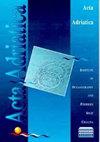The influence of feeding on muscle tissues composition in cage reared bluefin tuna (Thunnus thynnus)
IF 0.6
4区 生物学
Q3 MARINE & FRESHWATER BIOLOGY
引用次数: 1
Abstract
Capture-based tuna aquaculture rates as one of the most important aquaculture activities in Cro-atia, where juvenile tuna are reared in cages for over a year long period in order to increase substan-tially their weight. The aim of this study was to assess the effect of length and intensity of feeding on biochemical composition (total fat, moisture, dry matter, carbohydrates and protein content) of tuna (Thunnus thynnus) white muscle tissues in newly caught tuna prior to feeding (NCTPF) versus far-med tuna kept in rearing circular cages in the Vela Grska Bay, Adriatic Sea (LAT 43°17’40,6984”N, LONG 016°28’58,4315”E (WGS84)) between 2001 and 2004. Farmed tunas from all cages were fed with the feed consisting of domestic small pelagic fish, or with mixtures containing North Sea herring (Clupea harengus) and Sardina pilchardus, for five months (cage 3), eight months (cage 4) or 21 months (cages 1 and 2). A low content of moisture and high content of dry matter including fat was observed in farmed tuna muscles compared to wild-caught tuna. In farmed tuna muscles, measured moisture was 55.26% in cage 1, 39.95% in cage 2, 54.64% in cage 3 and 49.70% in cage 4. These results are significantly lower than moisture measured in NCTPF (80.36%). Content of dry matter found in farmed tuna muscles also differed greatly between wild tuna (19.64%) and far-med tuna, but also between the cages (44.74% in cage 1, 60.05% in cage 2, 45.36% in cage 3 and 50.30% in cage 4). In NCTPF, muscle tissues total fat encompassed less than 1% of the total body weight, while it reached over 20% of total body mass in farmed fed tuna (20.62% in cage 1, 42.50% in cage 2, 20.97% in cage 3 and 20.57% in cage 4). These results demonstrate that high fat content can be achieved already after five months of intensive feeding. Higher content of proteins was also found in aquacultured tuna (18.60% in cage 1, 16.00% in cage 2, 15.09% in cage 3 and 20.58% in cage 4) compared to wild-caught tuna (13.77%). There were no differences in carbohydrates con-tent between tuna farmed in different cages and NCTPF tuna, indicating glycogen as a less optimal indicator of muscle tissue quality in farmed tuna of the present study.饲养对笼养蓝鳍金枪鱼肌肉组织组成的影响
以捕获为基础的金枪鱼水产养殖率是克罗地亚最重要的水产养殖活动之一,在克罗地亚,幼年金枪鱼被关在笼子里饲养一年多,以大幅增加体重。本研究的目的是评估喂食的长度和强度对新捕获的金枪鱼(Thunnus thynnus)白肌肉组织的生化组成(总脂肪、水分、干物质、碳水化合物和蛋白质含量)的影响,亚得里亚海(北纬43°17'406984“,东经016°28'584315”(WGS84))。将所有网箱养殖的金枪鱼喂食由国内小型远洋鱼类组成的饲料,或喂食含有北海鲱鱼(Clupea harengus)和沙丁鱼的混合物,为期5个月(网箱3)、8个月(笼子4)或21个月(牢笼1和2)。与野生捕获的金枪鱼相比,养殖的金枪鱼肌肉中水分含量低,干物质(包括脂肪)含量高。在养殖金枪鱼肌肉中,测得的水分在网箱1中为55.26%,在网箱2中为39.95%,在网箱3中为54.64%,在网箱4中为49.70%。这些结果显著低于NCTPF中测得的水分(80.36%)。养殖金枪鱼肌肉中的干物质含量在野生金枪鱼(19.64%)和远程养殖金枪鱼之间也有很大差异,但在网箱之间也有差异(网箱1中为44.74%,网箱2中为60.05%,网箱3中为45.36%,网箱4中为50.30%)。在NCTPF中,肌肉组织总脂肪不到总体重的1%,而在养殖喂养的金枪鱼中,总脂肪占总体重的20%以上(第1笼为20.62%,第2笼为42.50%,第3笼为20.97%,第4笼为20.57%)。这些结果表明,经过五个月的强化喂养,已经可以达到高脂肪含量。与野生捕获的金枪鱼(13.77%)相比,水产养殖的金枪鱼中的蛋白质含量更高(笼子1中为18.60%,笼子2中为16.00%,笼子3中为15.09%,笼子4中为20.58%)。不同笼子养殖的金枪鱼和NCTPF金枪鱼的碳水化合物含量没有差异,这表明糖原是本研究养殖金枪鱼肌肉组织质量的最佳指标。
本文章由计算机程序翻译,如有差异,请以英文原文为准。
求助全文
约1分钟内获得全文
求助全文
来源期刊

Acta Adriatica
生物-海洋与淡水生物学
CiteScore
1.60
自引率
11.10%
发文量
13
审稿时长
>12 weeks
期刊介绍:
Journal "Acta Adriatica" is an Open Access journal. Users are allowed to read, download, copy, redistribute, print, search and link to material, and alter, transform, or build upon the material, or use them for any other lawful purpose as long as they attribute the source in an appropriate manner according to the CC BY licence.
 求助内容:
求助内容: 应助结果提醒方式:
应助结果提醒方式:


